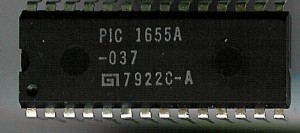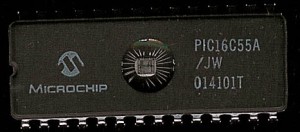March 28th, 2009 ~ by admin
Microchip has now shipped almost 7 billion of the legendary PIC processor line. Still being made, and improved today, the PIC has been around for a very very long time. General Instruments created the PIC16 in 1975 to make up for the bad I/O of their CP1600 line. Later GI spun this off into Arizona Microchip Technologies in the late 1980’s and what is known today as simple Microchip.

GI PIC1655A
Here is an original PIC1655A made in 1979.

Microchip PIC16C55A
And here is the same part (albeit now in CMOS) made in late 2001. Old designs such as the PIC, and the MCS-51 remain immensly popular, they are inexpensive, and have over 30 years of code base to work with.
March 2nd, 2009 ~ by admin
Recently we have talked a lot about two important CPU architectures, the XAP, and the ARM. ARM recently announced the Cortex-M0 which is implemented in 12,000 gates. Today we received some samples from Ember, makers of very efficient ZigBee wireless chips. Their two main ZigBee solutions are the EM250 SoC, and the EM260 co-processor. As the heart of each of these designs is a XAP2b processor core. a 16 bit RISC design running at 12MHz and implemented in 12,000 gates.

Ember EM250 & EM260 XAP cored ZigBee SoC's
The EM250’s chip area of a mere 7mm square, but pack an enormous punch, integrating a complete ZigBee wireless radio, 128Kb of flash, and 5Kb of RAM.
February 20th, 2009 ~ by admin
In a recent deal to try to solve their cash problems, and streamline profitability, Zilog sold off its secure transaction products (namely 32bit ARM processors) to Maxim (who through the purchase of Dallas, makes many MCS-51 controllers), They also sold off their wireless division to Maxim (and the software portion of this to a company called UEI)
What does this leave? Essentially the classic Z80 processor that has been around for the last 33 years, and all the related extentions there of. Old designs tend to stick around for a long time, and the Z80 is no exception.
Source: EE Times
February 4th, 2009 ~ by admin
So I bought some chips on eBay, they arrived, and are New Old Stock, made in 2004, really fairly recent. I have a datasheet for them that is marked Winbond which I found rather strange, since the chips, as you can see are marked National. This in itself isn’t super unusual. Occasionally a smaller company will use a larger companies markings to get design wins. The larger company acts in essance like a co-signer, validating and approving of the design.

National PC97551
Winbond isn’t small though, and the datasheet was marked 2006. A quick look on Winbond’s site shows no info on this chip. Turns out Winbond spun off their controller business to a company called Nuvoton. And how did Winbond get the desgin? Yup, National sold off their Super I/O and embedded controller division to Winbond in 2005.
And it is of course a processor, in this case a 16bit RISC processor running at 20MHz based on the (formerly) National CompactRISC architecture.
February 3rd, 2009 ~ by admin
When designing a system, the best performance is often reached by using an ASIC, you can customize it to your design and tweak it for maximum performance. This, however, adds costly development time, and little flexiblility. You could use a general purpose processor; this saves dev time, and cost, but at the expense of performance. What if you could have both? Off the shelf processor technology, AND customizable speed.
You can. This is what Software Configurable Processors are designed for. In simple terms they are a standard CPU core, wrapped in a FPGA. This way istructions for the processort can be configured for maximun speed. If you have a function in your code that is repetitive, it can be reduced to a single instruction for the processor.

One of the leaders in Software Configurable Processors is called Stretch. Their S6000 line of processors use a Tensilica Xtensa core (a VLIW RISC design), wrapped in a custom FPGA. In this way the RISC core can be programmaed on the fly, providing much faster performance then a normal processor, or DSP.
January 16th, 2009 ~ by admin
Today while browsing the teardown section on Embedded.com I came across an article about a Kodak picture frame. At its heart was a processor by a company called Amlogic. They make among other things, processors for digital picture frames. Their website doesnt have much more info about their products. It appears many of their devices are based on a variety of ARM cores (as often is the case.

If anyone knows anything more about this company, or its interesting processors, let us know







